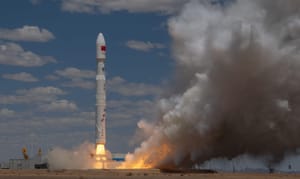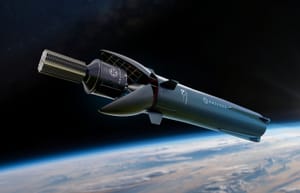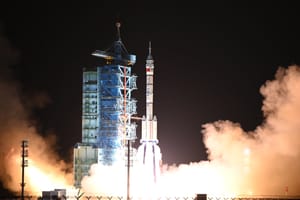
Aug 2, 2024
Get to know CAS Space!
CAS Space is one of China's many commercial launch providers, and it currently operates one of the most capable launch vehicles available in the Chinese commercial launch market. However, outside of aerospace enthusiast circles, CAS Space remains somewhat unknown in the West. So who is CAS Space? and what rockets do they launch?
Launch Vehicles
Both of CAS Space's vehicles are called Kinetica globally or 力箭 (Lì jiàn in Pinyin, or Power Arrow directly translated to English) in China. CAS Space's Marketing & Planning Department summarised the naming process as follows:
"There had been some confusion about the name in the global community. Before it was named in Chinese as “力箭”, it had an internal code of “中科一号A”, a.k.a. ZK-1A. The code was a nod to the root of the Chinese Academy of Science for many of our engineers prior to their venture into the commercial sector. The code was discontinued in favor of “力箭” as we updated our roadmap. It received an updated internal R&D code of “PR-1”, literally “Power Rocket 1”. The name was used in our engineering and sometimes was seen in public as well. We decided that it was not a good name to publicize internationally, so a different name had to be chosen. The most obvious choice is the transliteration of “力箭一号”, that is, “Lijian-1”. However, for non-mandarin-speakers, the name may be pronounced like “Laji”, meaning ‘junk’. Many of us voted the name off for this reason. Eventually, a version to translate “力箭” by conveying the meaning behind it was chosen."
"Now the launcher series is called “力箭” in Chinese and “Kinetica” globally."
Kinetica-1 (力箭一号)
Kinetica-1 is CAS Space's first launch vehicle, which has so far launched three times, all successfully. The launch vehicle consists of four stages, all burning solid fuel.
The Kinetica-1 launch vehicle can carry up to 2,000 kilograms to low Earth orbit or 1,500 kilograms to a 500-kilometer sun-synchronous orbit. CAS Space offers the ability to launch a single satellite to utilize all of the rocket's payload capacity, however more 'rideshare' missions occur for multiple satellites to be delivered in one launch.

Each of Kinetica-1's stages are as follows:
- First-stage: The first stage is propelled by a solid rocket booster that burns an undisclosed solid fuel to produce 200 tons of thrust.
- Second-stage: The second stage is propelled by another solid rocket booster that generates 110 tons of thrust using the same unidentified solid propellant.
- Third-stage: The third stage is propelled by another solid rocket booster that generates 110 tons of thrust using the same undisclosed solid propellant.
- Fourth-stage: The fourth stage is propelled by a solid rocket booster, which burns the same unidentified solid propellant to provide 8 tons of thrust.
Currently, all three of Kinetica-1's launches have occurred from the Jiuquan Satellite Launch Center, in Northern China. However, CAS Space, like OrienSpace and Galactic Energy, has shown an interest in launching from a sea launch platform, likely from a ship based out of the Haiyang sea launch spaceport.
On its launch pad, Kinetica-1 weighs 135,000 kilograms and stands at 30 meters tall. The first two stages and fairing have a diameter of 2.65 meters, giving the rocket is unique look.

Kinetica-2 (力箭二号)
Kinetica-2 is CAS Space's in-development two-stage partially reusable launch vehicle, with a first flight scheduled for Summer of 2025. Unlike most reusable rockets in development currently, Kinetica-2 will recover the three 'common booster cores' as one.
CAS Space is currently hoping to have Kinetica-2 carry payloads weighing up to 12,000 kilograms to low Earth orbit, or 8,000 kilograms to a sun-synchronus orbit.

Each of Kinetica-2's stages are as follows:
- First-stage: The first-stage of Kinetica-2 consists of three 'common boosters cores' each with three YF-102 engines generating 85 tons of thrust each. With three cores the launch vehicle has nine YF-102 engines for a total thrust of 766 tons. For propellant, the first-stage will burn rocket-grade kerosene and liquid oxygen.
- Second-stage: The second-stage of Kinetica-2 will have one vacuum-optimized YF-102 engine while generating a believed thrust of over 85 tons. It will also burn rocket-grade kerosene and liquid oxygen.
Each 'common booster core' is 3.35 meters in diameter, along with the second stage. For landing of the first-stage, the three boosters will land as one unit downrange on a landing pad or drone ship. The landing legs and grid fins for recovering the first-stage will be placed across the three cores to enable landing.
On the launch pad, Kinetica-2 will be 52 meters tall and weigh 625,000 kilograms fully fuelled. Kinetica-2's fairing will also be 4.2 meters in diameter.

CAS Space is also considering a more capable version of Kinetica-2, called Kinetica-2H. Kinetica-2H will have five 'common booster cores' on the first stage, having 15 YF-102's generating 1276 tons of thrust at liftoff.
With the additional 'common booster cores', Kinetica-2H's expected payload capacity is 22,000 kilograms to low Earth orbit, or 15,000 kilograms to a sun-synchronus orbit.
On the launch pad, Kinetica-2H will be 56 meters tall and weigh 913,000 kilograms fully fuelled. Kinetica-2H will also allow the customers to choose between a 4.2 or 5-meter diameter fairing.
Questions for CAS Space
While talking with CAS Space's Marketing & Planning Department for this article, I asked the company a handful of questions. The company's answers to each question is listed below.
Is the inaugural launch the only flight planned of Kinetica-2 in 2025?
"The second flight is planned for Q1 2026. We do have a few missions queued so it is quite likely that we will have two launches eventually in 2025."
In the years after the inaugural launch what is the desired launch frequency of Kinetica-2?
"Our expectation is there will be half a dozen launches for 2026, and about 20 launches each year afterwards."
Will Kinetica-2's first stage be capable of flying back to the launch site for re-use, or will it be limited to landings downrange from the launch site?
"It will land downrange to a landing site or a sea platform."
How many flights are the Kinetica-2 first stages planned to perform via re-use?
"More than 20 times."
Leading up to the first stage landing, will CAS Space perform sub-orbital hops with a vertical-takeoff vertical-landing vehicle?
"We have monthly R&D milestones planned out for reusability. The tests will be planned from more of an engineering perspective than from a PR perspective, and we will share more details once the milestones prior to the test are completed."
Is Kinetica-2 still planning to use the YF-102 kerosene-oxygen rocket engine, if so how many per launch vehicle?
"There will be ten YF-102s in total. Nine will be used on the first stage (3 on each booster), and a vacuum version of the YF-102 will be used on the second stage."
Alongside launching China's ten thousand spacecraft+ constellations, are there still plans for car-pooling/rideshare launches as we have seen with Kinetica-1?
"Yes! While the primary payloads do come first, we always welcome ridesharing to provide the most efficient and accessible options to smaller satellites globally."
Will Kinetica-1 be gradually phased out in favor of Kinetica-2 once it begins reliable frequent flights?
"Kinetica-1 and Kinetica-2 serve a different spectrum of missions. The flight frequency for each launcher will be determined by market demands. Our expectation is that the demand for Kinetica-1 will continue to be strong. Either launcher is financially sustainable for us so there is really no plan in phasing out Kinetica-1. "
Who is CAS Space?
CAS Space, or Chinese Academy of Sciences Space, is a Chinese launch provider partially owned by the Chinese Academy of Sciences. The company was founded in 2018 in Beijing but is currently headquartered in Guangzhou, in the province of Guangdong in southern China.
The company has wholly-owned subsidiaries located in Guangzhou, Beijing, and Xi'an for manufacturing as well as research and development. The Beijing subsidiary focuses on research and development, the Guangzhou subsidiary focuses on CAS Space's manufacturing operations, and the Xi'an subsidiary focuses on various propulsion technologies.
CAS Space also operates its own launch facilities at the Jiuquan Satellite Launch Center. This facility includes a launchpad along with space to store payloads and up to ten launch vehicles.
The company's 'mission and vision' is to build simple, sophisticated, and reliable launch vehicles to usher in an inclusive, accessible, and peaceful era of space exploration. To achieve this, CAS Space employs approximately 300 people, with its team consisting of new industry talent and veterans of the Long March rocket programs.

Part of the information, and images, in this article would not have been available without the patience and efforts of CAS Space's Marketing & Planning Department, whom I would like to thank for answering some of my questions and understanding my somewhat basic Chinese writing.



